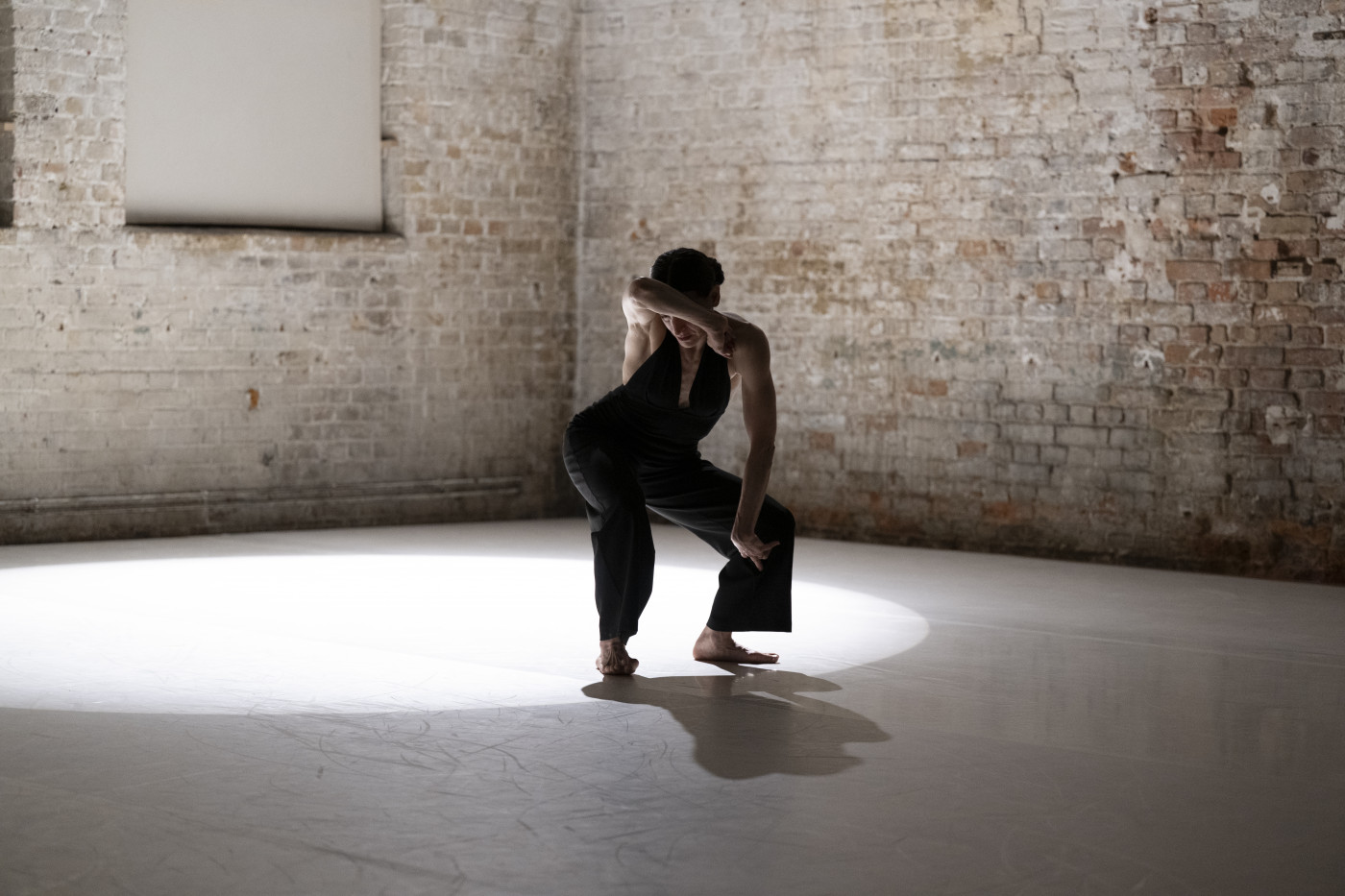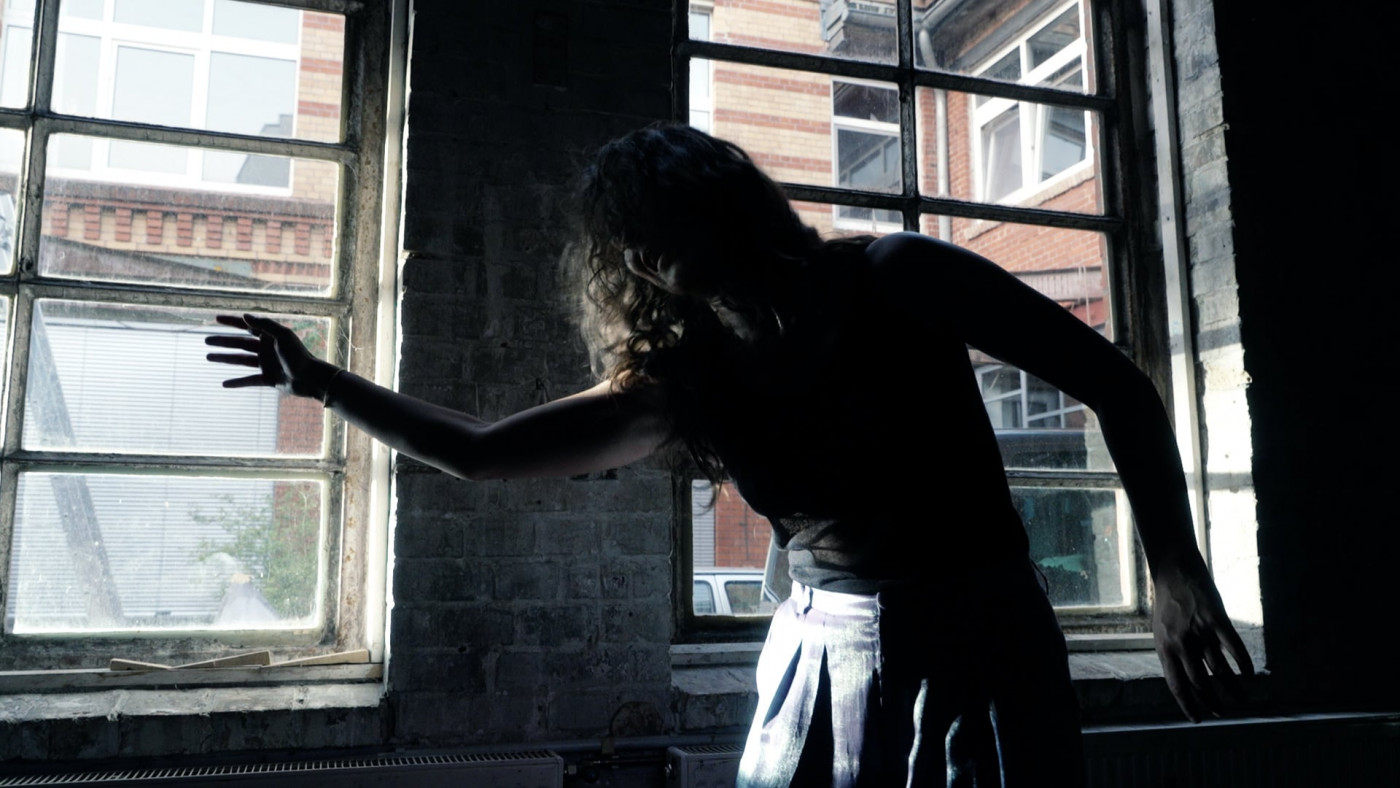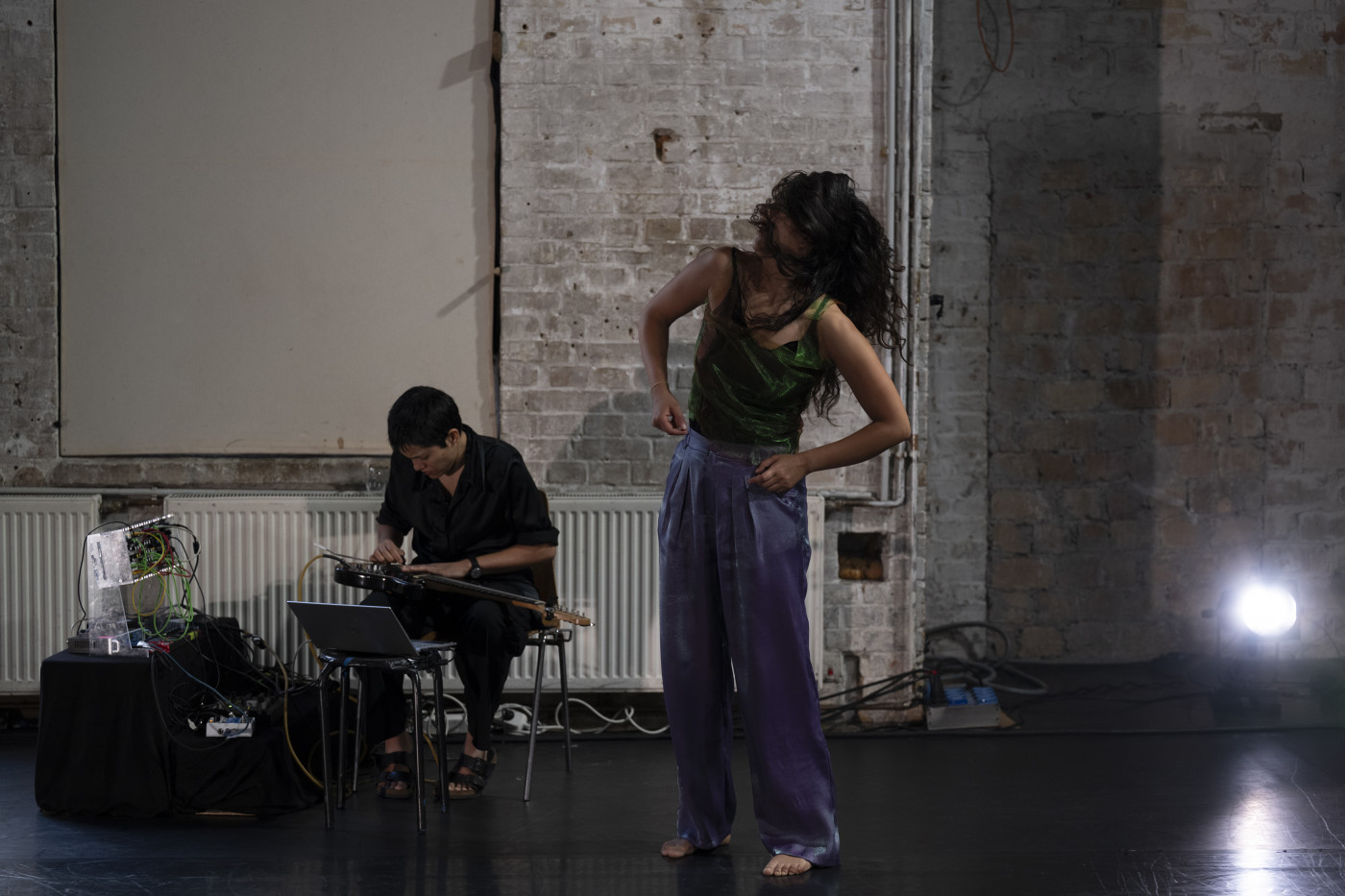
Choreoacoustic transformations
Individual, precisely placed sounds emerge from the semi-darkness. The stage remains empty for about five minutes. Then dancer Maria Colusi stumbles onto the stage, cautiously feeling her way into the circle of light that defines the performance space. Her movements begin large, then become smaller, tighter, quicker—ultimately circling only her own slender body. The scene resembles a struggle against an inner resistance. Time and again, the dancer vanishes into the edge of darkness, only to reappear as if something within her is trying to break free. A release, or perhaps a gesture of detachment. Suddenly, a scream—raw and abrupt. The atmosphere shifts with the entrance of the voice. The lighting changes, the sound becomes more electronic and rhythmic. The choreography moves closer to the floor, becoming more fluid, more gliding. The body loses its verticality and seeks new connections between sound, surface, and gravity.
In SWAP, the opening piece of the soundance festival berlin, created by dancer Maria Colusi and composer Edgardo Rudnitzky, sound is not merely an addition to the dance, but both an independent material and a source of inspiration. Rudnitzky’s compositions are not simply layered onto choreography—they are created in tandem with it. Here, sound becomes a physical event that shapes the space-time of the performance, influencing the choreography even as it is shaped by it in return.
SWAP doesn’t follow a linear narrative, but rather presents a physical-acoustic exploration: a play of transitions, friction, and dissolution – and at the same time it serves as a reflection on physical and emotional states, inspired by the ancient theory of the four humours, itself rooted in the classical concept of the four elements (fire, water, earth, air). In its pre-scientific logic, this theory intertwined physical, psychological, and cosmic dimensions. Humoral medicine did not see the human body as an isolated system, but rather as a porous structure in which internal and external influences, bodily organs and the environment, temperaments and celestial bodies are inextricably interwoven. It stands for a holistic understanding of the world in which everything is related and resonates with each other.
It is not about hierarchy or dominance—it is about balance, about equilibrium. It is about collaboration rather than competition, as in SWAP, where sound, movement, and light not only coexist, but shape, influence, and permeate one another. In this vibrating in-between space—where the body and its voice are understood as instruments and music as a form of movement—a dialogue begins that transcends the mere juxtaposition of dance and music. In their mutual translations, reconfigurations and transformations, in negotiations between resistance and concession, self-assertion and self-transformation, hybrid forms of expression emerge that undermine the boundaries between choreography and music and deepen an understanding of the interactions between sounds, movements, time and space.
The piece makes tangible what is at the centre of the soundance festival, which is taking place for the ninth time this year and has seen itself as a laboratory for encounters between sound and movement for years. It brings together artists who consciously undermine the boundaries between sound composition and choreography in favour of open experimentation with form, gesture, sound and rhythm. Rather than illustrating or accompanying one another, they compose, choreograph, and improvise in collaboration. When does movement become music, sound become gesture - and at what moment do both become choreography? How does choreography evolve in collaboration with musicians—and how does music transform when shaped by its choreographic staging?
These reciprocal transformations, translations and frictions open up a different perception of the relationships between sound and space, movement and time. The physicality of sound and music—their material yet invisible presence in space— emerges clearly by becoming a bodily experience: something that vibrates, presses, expands, withdraws... A state of mutual attention arises in which the sensory and the imaginary enrich one another.
This kind of open resonance space also forms the starting point for AURORA, a collaborative improvisation by Ale Hop (sound), Lina Gómez (dance), and Bruno Pocheron (light), dedicated to twilight as a threshold state.
The beginning is quiet and tentative: the sound unfolds in delicate, shimmering, pulsating tones – like a slow awakening. Individual notes expand into two-dimensional resonances, are fragmented, distorted, and played in reverse. The result is an oscillating stream of sound particles: sharp-edged, soft, sometimes booming, hammering. The form remains open—more a state than a progression—shaped by overlapping impulses beneath which quiet tension vibrates.
Ale Hop works with electro-acoustically processed electric guitar, digital effects, and synthesizers to create a multi-layered soundscape that ranges from soft chirping to monstrous stomping. The guitar is not played as a classical instrument, but as a sound-producing object - it chirps, scratches, hisses and hums.
Lina Gómez initially sits motionless leaned against the studio wall, listening. Gradually, she starts to move—vertebra by vertebra, she straightens, as if her spine is responding directly to the sound’s vibrations. Her body unfolds in many directions, twisting as though she were untangling herself from the inside out. Under Bruno Pocheron’s lighting, the shadows she casts on the back wall amplify this sense of complexity. Her face disappears behind falling hair, her expression remaining unreadable.
In AURORA, a sensitive dialogue unfolds between sound, dance, and light: a mutual absorption, transformation, and reflection of impulses. It is a choreographic act of listening, a synaesthetic process in which movement, light, and sound spiral together. Ale Hop crafts a finely tuned dramaturgical arc of tension that never veers into the spectacular, but instead draws the audience deep into a sonic microcosm. Through electronic manipulations, she evokes shifting sensations of proximity, distance, vastness, and depth. Melodious fragments emerge and dissolve. The music thrives on breaks and overlays, on the tension between analogue and digital, between control and the illusion of its loss—until the atmosphere begins to shift: the sound grows denser, darker, more abrasive. Harsh drones and glowing feedback slice through the room. Lina’s gaze—now clearly visible—becomes direct and insistent. The lighting shifts: diagonal shadows cut across the space, and queer trails of light open up new spatial dimensions. Gómez’s movements draw closer to the ground—her feet, legs, her entire body seem anchored to the floor. Gravity appears to intensify, reinforced by rhythmically repeated guitar riffs that Ale Hop sends swirling through the space.
Sound, light, and body converge into a shared undertow, unfolding simultaneously inward and outward. AURORA remains suspended between dissolution and condensation.
The music relinquishes its claim to inviolability, and the choreography lets go of its claim to visibility. Movements become sound-generating actions, while sound choreographs their own presence in space. The body inscribes itself into the music, while sound shapes the movement. The result is a nuanced intermediate space where meanings shift, hierarchies dissolve, and perception is recalibrated. Sound acquires a physical presence that becomes palpable; the movement, on the other hand, gains an acoustic trace, an echo in the space that reaches beyond the visible. What emerges is not a mere addition, but a mutual transformation - a choreo-acoustic topography in which time, space, body and sound are mapped anew.
Berlin, 26/06/2025

By playing this video, you accept Vimeo´s privacy policy. Read more in our privacy policy and at https://vimeo.com/privacy.

